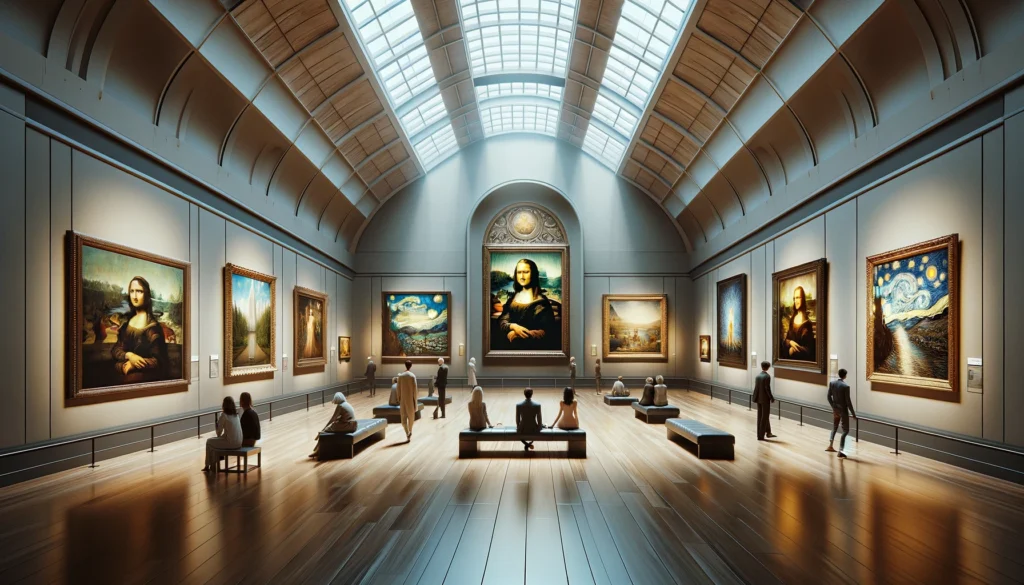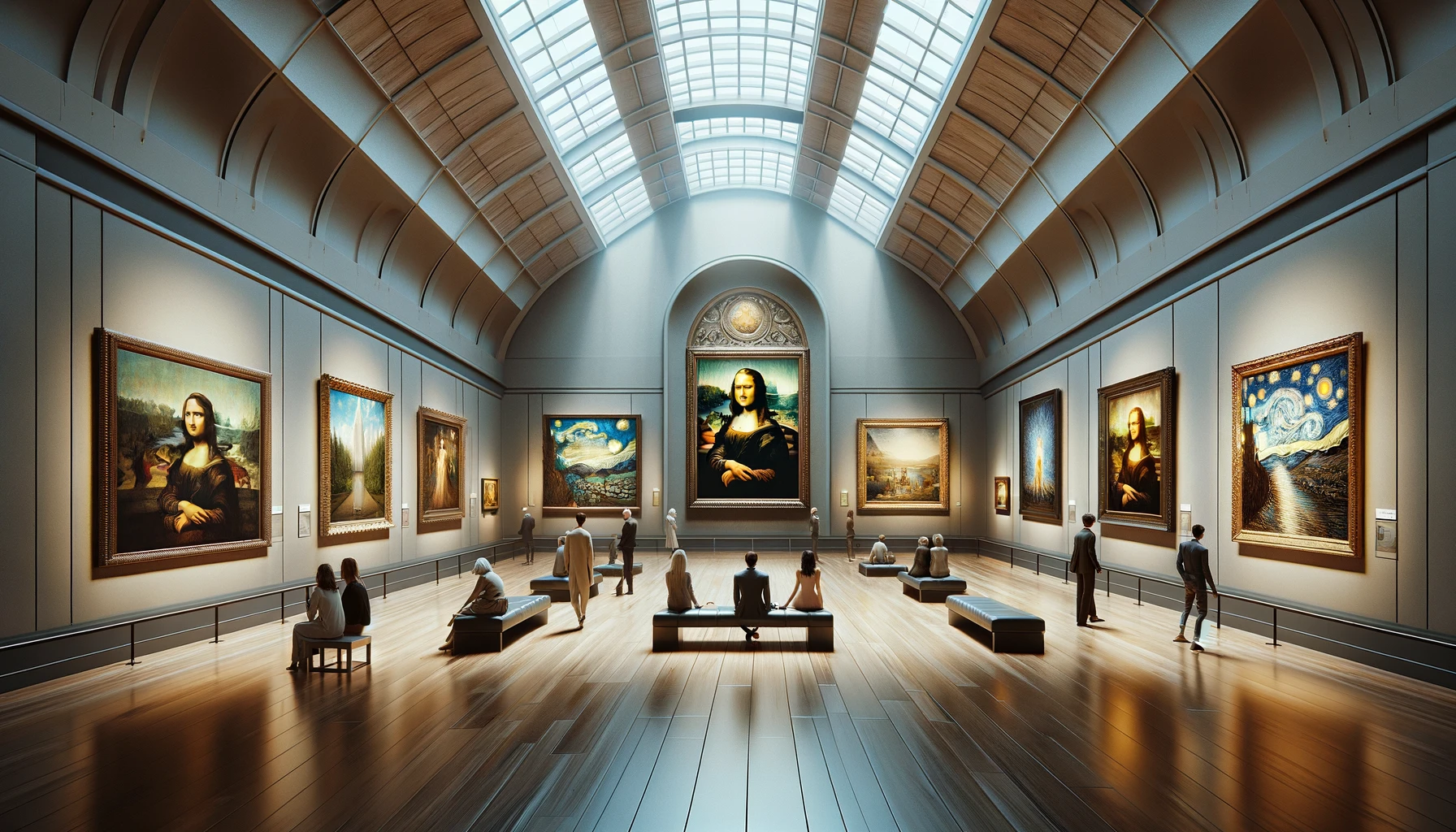Iconic Art: Famous Artwork
When we think about iconic art, certain masterpieces immediately spring to mind. These works transcend time and culture, captivating audiences across generations. But what makes a piece of art “iconic”? In this section, we’ll dive into the stories behind some of the most famous artworks in history, exploring their significance and the reasons they have achieved iconic status.
The Mona Lisa by Leonardo da Vinci
Let’s start with arguably the most famous painting in the world: the Mona Lisa. Created by Leonardo da Vinci in the early 16th century, this portrait of Lisa Gherardini, the wife of a Florentine merchant, is renowned for its exquisite detail and the enigmatic expression on the subject’s face. The Mona Lisa’s smile has intrigued and puzzled art lovers for centuries, inspiring countless theories and interpretations.
But why is the Mona Lisa so iconic? Part of its allure lies in Leonardo’s revolutionary technique. He employed sfumato, a method of blending colors and tones so subtly that there are no harsh lines, creating a lifelike, almost ethereal quality. Additionally, the painting’s theft from the Louvre in 1911 and its subsequent recovery brought it international fame. Today, millions flock to see this masterpiece, its allure undiminished by the passage of time.
Starry Night by Vincent van Gogh
Another artwork that has captured the imagination of millions is Vincent van Gogh’s Starry Night. Painted in 1889 while Van Gogh was in a mental asylum in Saint-Rémy-de-Provence, the swirling night sky and vibrant colors of Starry Night are instantly recognizable. The painting is a reflection of Van Gogh’s emotional turmoil and his fascination with the night sky.
Starry Night’s iconic status can be attributed to its emotional depth and Van Gogh’s unique style. The intense brushstrokes and bold use of color convey a sense of movement and energy, making the night sky come alive. This painting exemplifies Van Gogh’s ability to transform his inner experiences into a visual language that resonates universally.
The Persistence of Memory by Salvador Dalí
Salvador Dalí’s The Persistence of Memory, created in 1931, is another masterpiece that has become an icon of modern art. The painting features melting clocks draped over a barren landscape, evoking a dreamlike, surreal quality. Dalí’s work challenges our perception of time and reality, offering a glimpse into the subconscious mind.
The Persistence of Memory’s fame stems from its originality and the way it captures the essence of Surrealism. Dalí’s meticulous detail and bizarre imagery create a captivating and thought-provoking experience. This painting invites viewers to question their understanding of time, making it a timeless piece in the truest sense.
The Scream by Edvard Munch
Edvard Munch’s The Scream is one of the most recognizable images in art history. Created in 1893, this expressionist masterpiece depicts a figure with a horrified expression against a tumultuous sky. The Scream is a powerful representation of human anxiety and existential dread.
Munch’s use of bold colors and dramatic lines intensifies the emotional impact of the painting. The Scream resonates with viewers because it taps into a universal experience of fear and alienation. Its enduring popularity is a testament to Munch’s ability to convey deep psychological states through his art.
Girl with a Pearl Earring by Johannes Vermeer
Johannes Vermeer’s Girl with a Pearl Earring, often referred to as the “Mona Lisa of the North,” is another iconic work that has captivated art lovers for centuries. Painted in the mid-17th century, this portrait of a young girl wearing an exotic dress and a large pearl earring is known for its subtle play of light and shadow.
The painting’s mystique lies in the girl’s enigmatic gaze and the realistic portrayal of her features. Vermeer’s masterful use of light creates a sense of intimacy and immediacy, drawing viewers into the scene. Girl with a Pearl Earring continues to inspire fascination and intrigue, embodying the timeless appeal of Vermeer’s work.
The Last Supper by Leonardo da Vinci
Leonardo da Vinci makes our list again with The Last Supper, a mural painted in the late 15th century on the wall of the Convent of Santa Maria delle Grazie in Milan. This depiction of Jesus and his disciples, when Jesus announces that one of them will betray him, is a cornerstone of Western art.
The Last Supper’s iconic status is due in part to Leonardo’s innovative approach to composition and perspective. He created a sense of depth and realism that was groundbreaking for its time. The expressions and gestures of the figures convey a range of emotions, making the scene dynamic and engaging. Despite its fragile state, The Last Supper remains a profound influence on art and culture.
Guernica by Pablo Picasso
Pablo Picasso’s Guernica is a powerful political statement and an enduring symbol of the horrors of war. Painted in 1937 in response to the bombing of the Basque town of Guernica during the Spanish Civil War, this large mural depicts the chaos and suffering caused by the attack.
Guernica’s stark, monochromatic palette and fragmented forms convey a sense of destruction and despair. Picasso’s use of Cubist techniques to depict human and animal figures in disarray creates a visual impact that is both shocking and moving. Guernica has become an iconic anti-war symbol, reminding us of the devastating impact of conflict.
The Birth of Venus by Sandro Botticelli
Sandro Botticelli’s The Birth of Venus, painted in the late 15th century, is a quintessential example of Renaissance art. This mythological painting depicts the goddess Venus emerging from the sea on a shell, surrounded by other figures from classical mythology.
The Birth of Venus is celebrated for its graceful composition and Botticelli’s delicate handling of color and line. The painting’s depiction of divine beauty and idealized forms has made it an enduring symbol of Renaissance ideals. Its influence can be seen in countless works of art that followed.
American Gothic by Grant Wood
Grant Wood’s American Gothic, painted in 1930, is one of the most parodied and recognized images in American art. This portrait of a stern-looking farmer and his daughter standing in front of their house is often interpreted as a commentary on rural American values during the Great Depression.
The painting’s iconic status is partly due to its ambiguous nature. Viewers are left to interpret the relationship between the figures and the meaning behind their expressions. Wood’s meticulous detail and the painting’s striking composition contribute to its lasting impact.
The Thinker by Auguste Rodin
Lastly, we have The Thinker by Auguste Rodin, a sculpture that has become synonymous with intellectual contemplation. Created in the late 19th century, this bronze figure of a man deep in thought is part of Rodin’s larger work, The Gates of Hell.
The Thinker’s iconic status is due to its powerful expression of human thought and emotion. Rodin’s ability to convey a sense of inner turmoil and reflection through the figure’s pose and musculature is remarkable. The Thinker continues to be a symbol of philosophical inquiry and human introspection.

Understanding Iconic Art
So, what makes these artworks iconic? It’s a combination of factors, including the artist’s skill, the emotional and intellectual impact of the work, and its ability to resonate with audiences across time and cultures. Iconic art challenges our perceptions, evokes deep emotions, and often reflects the society and era in which it was created.
These masterpieces offer more than just visual pleasure; they provide insight into the human condition and the creative genius of their creators. By exploring the stories behind these famous artworks, we gain a deeper appreciation for their significance and the timeless qualities that make them enduring icons of art history.

